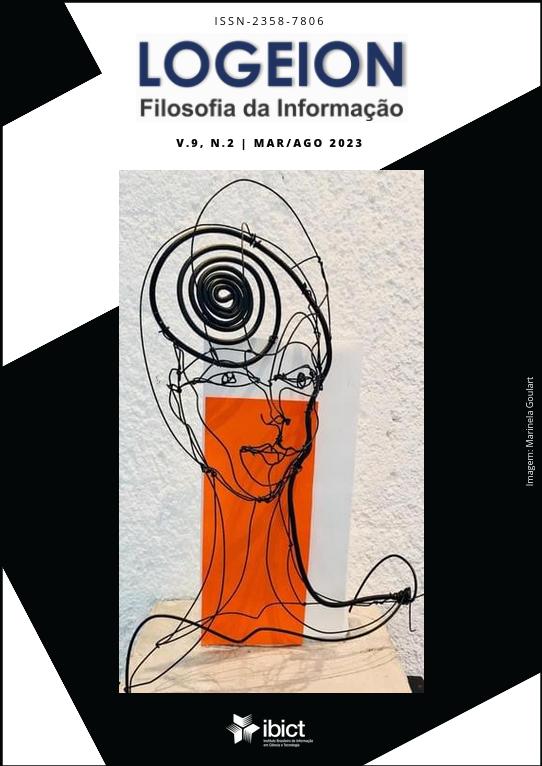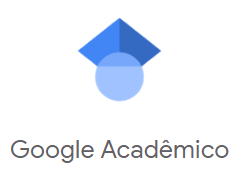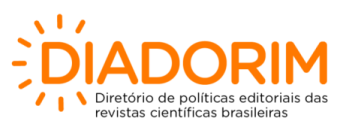THERMOLOGICAL PLURALISM AND INFORMATION DISORDER
Sharing digital environments in scientific communication and dissemination
DOI:
https://doi.org/10.21728/logeion.2023v9n2.p86-105Keywords:
Information Disorder, Terminology of Social Networks, Scientific Communication, Scientific divulgationAbstract
The research points out the conditions that motivated the changes in the processes of dissemination of science, presenting the environment of digital social networks as unified spaces of scientific communication and dissemination. From this context, it seeks to show how these spaces are vulnerable to information disorder. To this end, the main factors related to disorder in the digital space were raised, especially in these processes, and some precautions that need to be considered to avoid or minimize this problem were indicated. This is a bibliographic research of a qualitative nature, which sought, from a literature review, inferences and interpretations, to connect the information disorder to the careless with the terminologies used in scientific communication and dissemination. It is considered that, so that the promotion of science mediated by social networks is not permeated by disorders, it is necessary for producers and disseminators of scientific content to consider that this space has peculiarities that combine a heterogeneous audience and a particular form of communication and dissemination.
Downloads
References
BUENO, W. C. Comunicação cientifica e divulgação científica: aproximações e rupturas conceituaiss. Informação & Informação, Londrina, v. 15, n. 1, p. 1-12, 2010. Disponível em: https://www.uel.br/revistas/uel/index.php/informacao/article/view/6585. Acesso em: 20 out. 2021.
BUCHANAN, Carrie. Revisiting the UNESCO debate on a New World Information and
Communication Order: Has the NWICO been achieved by other means? Telematics and
Informatics, California, v. 32, n. 2, p. 391-399, 2015. Disponível em:
https://www.academia.edu/7510736/Revisiting_the_UNESCO_debate_on_a_New_World_Information_and_Communication_Order_Has_the_NWICO_been_achieved_by_other_means. Acesso em: 08 set. 2022.
CABRÉ, M. T. La terminología hoy: concepciones, tendencias y aplicaciones. Ciência da Informação, Brasília, v. 24, n. 3, p. 1995. Disponível em: http://revista.ibict.br/ciinf/article/view/567. Acesso em: 02 set. 2022.
CORREIA, F. A ilustração científica: “santuário” onde a arte e a ciência comungam. Visualidades, Goiânia, v. 9, n. 2, jul./dez., 2011. Disponível em: https://revistas.ufg.br/VISUAL/article/view/19864/12247. Acesso em: 25 set. 2022.
FERREIRA, O. M.; BORGES, D. S. L; SANGLARD, S. S. A comunicação nas redes sociais sob a ótica da translinguística. Revista Philologus, Rio de Janeiro, a. 22, n. 66, p. 83-91, set./dez., 2016. Disponível em: http://www.filologia.org.br/rph/ANO22/66supl/0005.pdf. Acesso em: 20 set. 2022.
FERREIRA, J. R. S.; SOUZA, E. D.; LIMA, P. R. S. A desordem da informação no contexto da covid-19: a responsabilidade de atuação dos líderes de opinião. In: Fábio Mascarenhas e Silva, Célio Andrade de Santana Júnior e Alexander Willian Azevedo. (Org.). Anais do X ENEGI: gestão da informação, desinformação em tempos da COVID-19. Recife: Néctar, 2021, v. 01, p. 28-37. Disponível em: https://pt.scribd.com/document/497631235/Anais-do-X-ENEGI-gestao-da-informacao-desinformacao-em-tempos-da-COVID-19. Acesso em: 27 out. 2022.
FRUET, F. S. O. et al. Internetês: ameaça à ou evolução na língua portuguesa?. Revista da ANPOLL, Brasília, v. 1, n. 26, 2009. Disponível em: https://revistadaanpoll.emnuvens.com.br/revista/article/view/131. Acesso em: 20 set. 2022.
GALLOTTI, M. M. C. Cartografia do domínio da comunicação científica mediada pela tecnologia digital. In: BORGES, M. M.; CASADO, E. S. Sob a lente da Ciência Aberta: olhares de Portugal, Espanha e Brasil. Imprensa da Universidade de Coimbra/Coimbra University Press, 2021. Disponível em: http://monographs.uc.pt/iuc/catalog/download/184/374/679-1?inline=1. Acesso em: 19 set. 2022.
HJØRLAND, B; SØNDERGAARD, T. F; ANDERSEN, J. Unisist model and knowledge domains. Encyclopedia of library and information science, Copenhagen, v. 4, p. 1-4, 2005. Disponível em: http://curis.ku.dk/ws/files/47044534/UNISIST_model_and_knowledge_domains.pdf. Acesso em: 20 ago. 2022.
HURD, J. M. Scientific communication: new roles and new players. Science & Technology Libraries. Chicago, v. 25, n 1-2, p. 5-22, 2004. https://silo.tips/download/scientific-communication-new-roles-and-new-players. Acesso em: 20 ago. 2022.
KILYENI, A. Likes, tweets and other “friends”: social media buzzwords from a terminology perspective. Procedia-Social and Behavioral Sciences, v. 192, p. 430-437, 2015. Disponível em: https://www.sciencedirect.com/science/article/pii/S1877042815035302. Acesso em: 20 ago. 2022.
KRIEGER, M. G.; FINATTO, M. J. B. Introdução à terminologia: teoria e prática. Editora Contexto, 2004.
MANESS, Jack M. Teoria da biblioteca 2.0: Web 2.0 e suas implicações para as bibliotecas. Informação & Sociedade: estudos, João Pessoa, v.17, n.1, p.43-51, jan./abr., 2007. Disponível em: https://brapci.inf.br/index.php/res/v/92256. Acesso em: 27 out. 2022.
MENEZES, A. H. N. et al. Metodologia científica: teoria e aplicação na educação a distância. Universidade Federal do Vale do São Francisco, Petrolina-PE, 2019.
OLIVEIRA, T. M. Midiatização da ciência: reconfiguração do paradigma da comunicação científica e do trabalho acadêmico na era digital. MATRIZes, São Paulo, v. 12, n. 3, set./dez., 2018. Disponível em: https://www.revistas.usp.br/matrizes/article/view/147868/149823. Acesso em: 28 set. 2021.
RODRÍGUEZ, V. G. O ensaio como tese: estética e narrativa na composição do texto científico. São Paulo, SP: WMF, 2012.
SANTIAGO, M. S.; ARAÚJO, J. Projeto termiredes: terminologia das redes sociais no brasil. In: MURAKAWA, C. A. A.; NADIN, O. L.; FERREIRA. A. A. G. D’Orange. (Org.). Léxico em Cena: contribuições para os estudos lexicais. São Paulo: Cultura Acadêmica, 2016. p. 207-221.
SILVA, S. F. R.; ALVES, F. M. M.; BARREIRAS, M. I. S. Comunicação científica: visão diacrônica de alguns subsídios teóricos. Revista Fontes Documentais. Aracaju. v. 2, n. 1, p. 67-87, 2019. Disponível em: https://brapci.inf.br/index.php/res/v/134707. Acesso em: 23 out. 2021.
SOARES, F. B. et al. Infodemia e Instagram: como a plataforma é apropriada para a produção de desinformação sobre a hidroxicloroquina?. Fronteiras-estudos midiáticos, São Leopoldo, v. 23, n. 2, p. 89-103, maio/ago., 2021. Disponível em: http://revistas.unisinos.br/index.php/fronteiras/article/view/22581. Acesso em: 20 set. 2022.
TARGINO, M. G. Comunicação científica: uma revisão de seus elementos básicos. Informação & Sociedade, São Bernardo do Campo, v. 10, n. 2, 2000. Disponível em: https://periodicos.ufpb.br/ojs/index.php/ies/article/view/326/248. Acesso em: 29 set. 2022.
VICENTE, N. I.; CORRÊA, E. C. D.; SENA, T. A divulgação científica em redes sociais na internet: proposta de metodologia de análise netnográfica. In: Encontro Nacional de Pesquisa em Pós-Graduação em Ciência da Informação, 16., 2015, João Pessoa. Anais [...] João Pessoa: UFPB, 2015. Disponível em: http://www.ufpb.br/evento/index.php/enancib2015/enancib2015/paper/viewFile/2853/1160. Acesso em: 25 out. 2022.
WARDLE, C.; DERAKHSHAN, H. Information disorder: toward an interdisciplinary framework for research and policy making. Council of Europe report, 2017.
Downloads
Published
Versions
- 09/03/2023 (2)
- 08/03/2023 (1)
Issue
Section
License
Copyright (c) 2023 Logeion: Filosofia da Informação

This work is licensed under a Creative Commons Attribution-NonCommercial-ShareAlike 4.0 International License.
The journal is published under the Creative Commons - Attribution - Noncommercial - Share Alike 3.0 Brazil.
The published work is considered collaboration and therefore the author will not receive any remuneration for this as well as anything will be charged in exchange for publication.
All texts are responsibility of the authors.
It’s allowed partial or total reproduction of the texts of the magazine since the source is cited.














